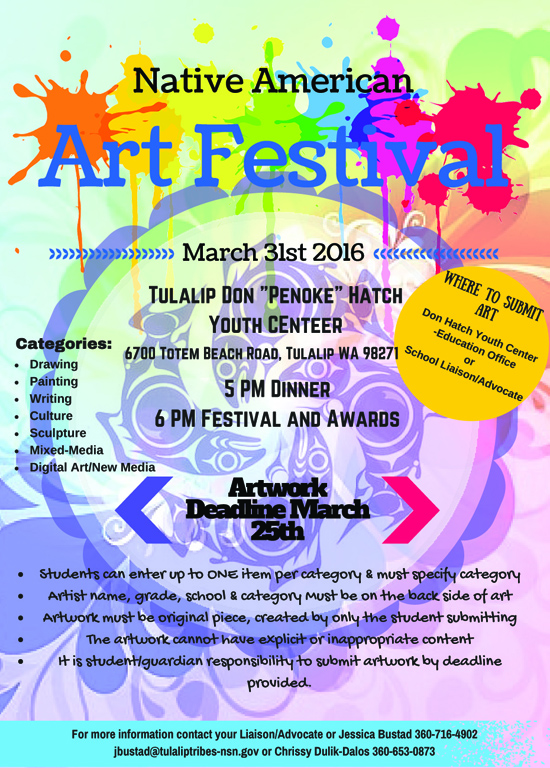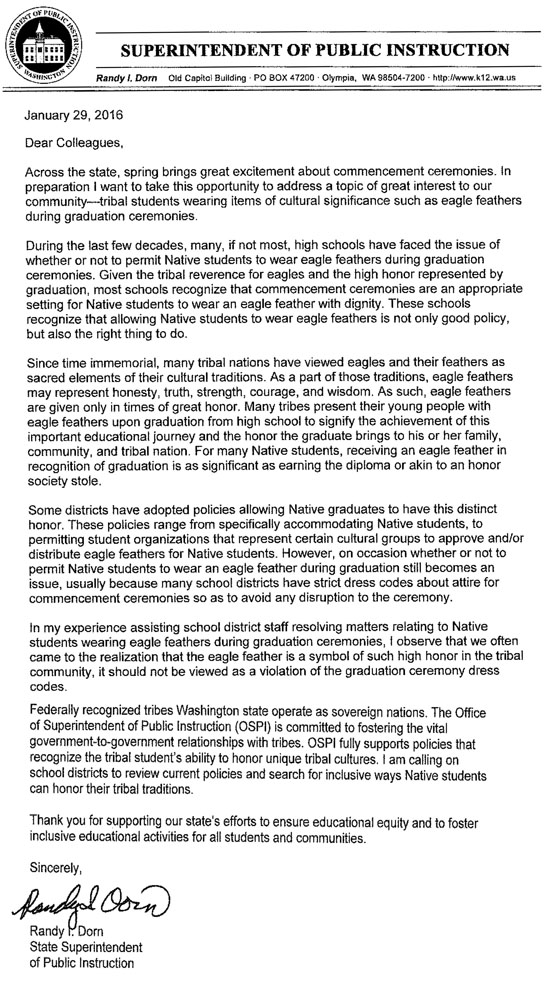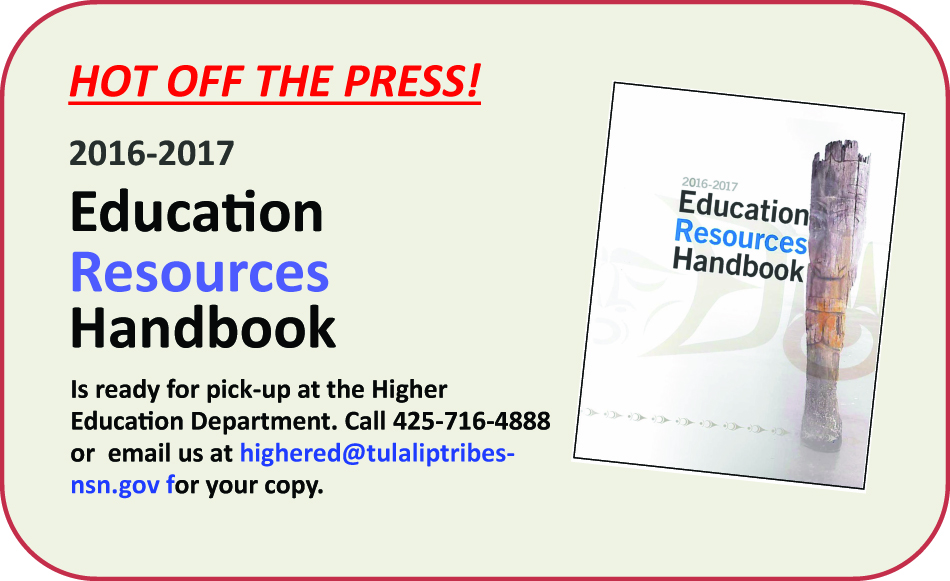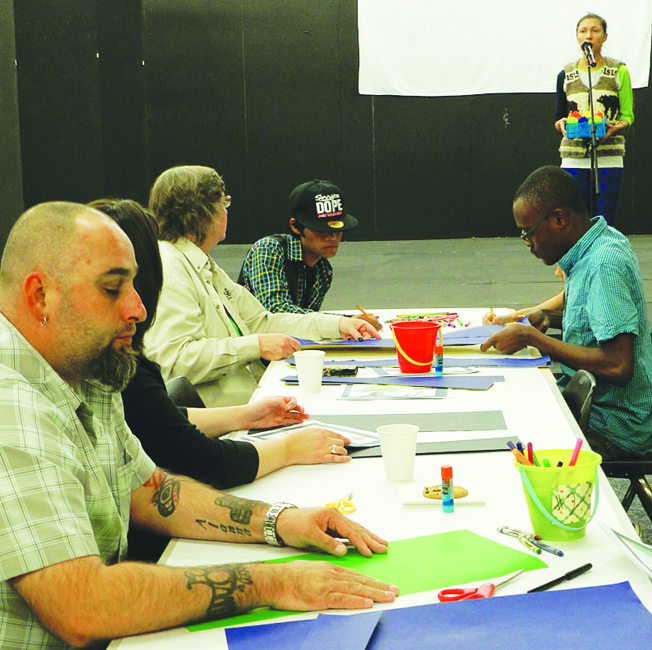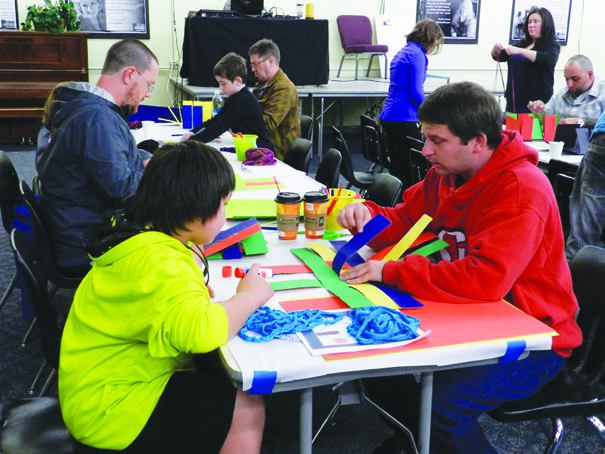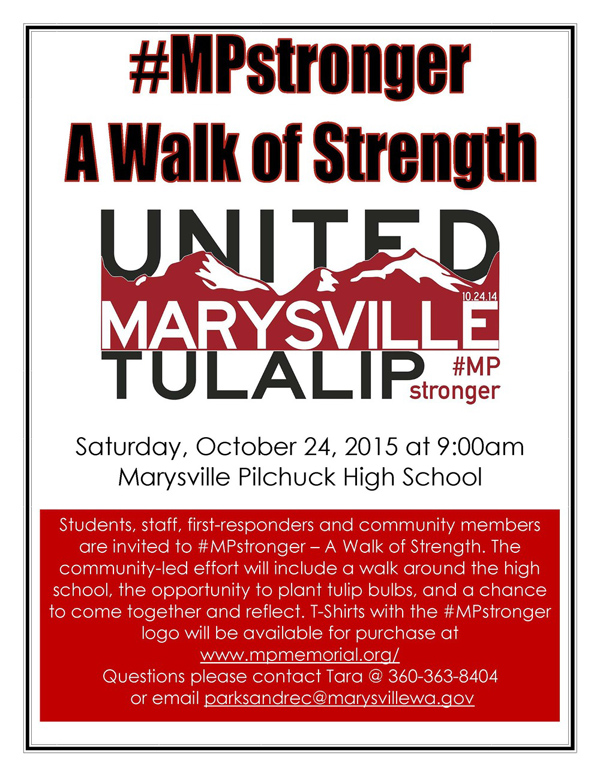Category: Education
Eagle Feather Letter from State Superintendent Randy Dorn
Tulalip Tribes Homework Support Program
Hot Off The Press: Education Resources Handbook
Strengthening our community: Red Curtain Arts Center hosts Tulalip culture night
by Micheal Rios, Tulalip News
On Friday, October 23, the Red Curtain Foundation for the Arts, in partnership with the Tulalip Tribes’ Lushootseed Language Department, hosted a free cultural event from 7:00 p.m. to 9:00 p.m. Tulalip tribal member and Lushootseed teacher, Maria Martin, shared the legend of “Her First Basket” in Lushootseed and English, accompanied by tribal illustrations and artwork.
Scott Randall, president of the Red Curtain Foundation for the Arts in Marysville, first approached Maria at the annual Raising Hands event in 2014 with his idea for bringing the Marysville and Tulalip communities together with a culture night.
“We, Scott and I, thought it would be beneficial to everyone in the Marysville and Tulalip communities. There is a separation between the two and we wanted to break down that wall,” stated Maria. “We know we can be a strong community, but there is so much unknown about one another. This event is just one way for our communities to come together and grow.
“We plan on having a story and activity once a month. It is a free event, with donations if you feel up to it. We just want to break down those walls of curiosity. I’m sure that there are many Natives/ Tulalip community members that have encountered some sort of silly question about Native Americans and how we live. This is a way to educate outsiders, to understand one another.”
Maria chose to share her favorite Lushootseed story “Her First Basket”, a core story in the Lushootseed Department’s values book, and pass along the significant meaning it holds to both her and her people.
“It’s a story about not giving up and there is a bit of community unity within it as well,” explains Maria. “A Cedar tree helps this little girl to see her potential and she gains friends for it. Bringing people together and seeing their potential, it’s something every teacher strives for.”
Marysville and Tulalip community members were invited to partake in the evening of culture. Each table within the auditorium had at its center a “Her First Basket” picture book, so that children and adults could follow along as Maria first told the story in her traditional language, Lushootseed.
Following the storytelling sessions, the audience members were taught some basic weaving skills, using paper and yarn as substitutes for traditional cedar strips, to create their own basket and memento from the evening.
“After telling the story in Lushootseed and in English, we worked on making paper and yarn baskets. For many it was their first basket. It was a fun experience, and people’s talents are so amazing,” says Maria. “I hope to see more community members from both the Marysville and Tulalip communities at future events. We are all related, we live right next to one another, and our care for our neighbors is so important. It was so nice to see the people that showed up; the outcome of their basket making was beautiful. Accomplishing something you haven’t done before is such a great feeling, and meeting new people with the new experience is a beautiful thing too. There are so many people out there that we can all learn something from.”
Contact Micheal Rios, mrios@tulaliptribes-nsn.gov
$2.1 million will support MPHS victims, responders
By Diana Hefley, The Herald
MARYSVILLE — The federal government announced Friday it will provide $2.1 million dollars to support victims, witnesses and first responders affected by last year’s shootings at Marysville Pilchuck High School.
The grant will pay for mental health and victim services, additional school counselors, suicide prevention efforts and other programs at the high school and throughout the district.
“We’re excited about this and what we’ll be able to do,” said Marge Fairweather, the executive director of Victim Support Services.
The nonprofit provides two trauma therapists who mainly work with students at Marysville Pilchuck. Fairweather plans to hire a case manager and third therapist to reach more students in other schools.
On Oct. 24, 2014, a high school freshman shot his friends. Four students were killed and a fifth was seriously wounded. Shooter Jaylen Fryberg, 15, then killed himself.
The school district, Marysville, the Tulalip Tribes, Victim Support Services and Volunteers of America initially applied for $4.2 million. The amount was refined to meet the guidelines established by the U.S. Department of Justice’s Office for Victims of Crime.
After the 1995 Oklahoma City bombing, Congress authorized the office to set aside $50 million a year to provide grants to victims and first responders after acts of terrorism or mass violence. The money comes from bond forfeitures and fines paid by white-collar criminals.
The federal office provided a $7.1 million grant for recovery efforts after a gunman in 2012 killed 20 students and six adults at Sandy Hook Elementary School in Newtown, Connecticut.
Family Engagement Night, Oct 29
‘Walk of Strength’ marks Marysville Pilchuck shooting milestone
By Rikki King, The Herald
MARYSVILLE — A community event is planned for the one-year milestone of the shootings at Marysville Pilchuck High School.
The event, called A Walk of Strength, will start at 9 a.m. Oct. 24 and will include a walk around the campus. The plan includes inviting people to plant red and white tulip bulbs as they “come together and reflect,” according to a news release.
The details are being coordinated by the city, the school district and the Tulalip Tribes.
“An unimaginable event occurred in our community last year that changed lives forever,” schools Superintendent Becky Berg said in the release. “But it does not define us.”
The walk is meant to be a safe and supportive way to remember together, Mayor Jon Nehring said. Tribal Chairman Mel Sheldon described each step as a symbol for healing and moving forward.
They’ve set up a website, www.mtunited.org, and a Facebook page called “Marysville/Tulalip United.”
T-shirts with the logo and “#MPstronger” branding are expected to go on sale at www.mpmemorial.org.
Oct. 24 will mark one year since a freshman at Marysville Pilchuck High School invited a group of friends to sit together in the main cafeteria. He shot five of them, four of whom were fatally wounded. He then took his own life.
Marysville schools will get more SROs
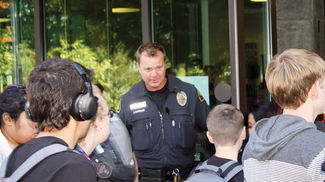
Marysville School Resource Officer Chris Sutherland holds a door open for students at Marysville Getchell High School during a passing period on Oct. 1.
By Christopher Andersson, North County Outlook
The Marysville Police Department will be able to more than double the number of officers that it assigns to local schools because of a recently received federal grant.
The federal Department of Justice’s Community Oriented Policing Services grant provided the city with $375,000 to fund three new full-time School Resource Officers (SROs).
Marysville Mayor Jon Nehring said that they had the idea for a “youth services unit” about three years ago that would help create “a strong presence not only in the schools, but also just where youth are hanging out after school as well,” he said.
Nehring added that the city is “trying to be proactive and prevent youth crime where we can.”
The police department currently employs two SROs and together they have responded to more than 7,600 calls ranging from assault, gang activity, theft and threats in the last five years.
“Everyone is focused on the same goal, and that’s providing a safe environment, so the more officers you have that just stay at their school, you’re going to have that presence” said current Marysville SRO Jeremy Wood.
The two current SROs in Marysville have to cover incidents across all the district’s schools, so they expect the extra three officers to help.
“It’s going to be an awesome help,” said Marysville SRO Chris Sutherland.
Currently the officers have to move between the schools frequently, he said.
“Once something happens in a middle school we have to leave our high school to go there. Usually, when we leave we’ll get a call to come back to the high school that’s like ‘hey, when are you going to be back, because we have this issue going on,'” he said.
“With only two SROs it’s going to be hard to cover all those schools and you get better coverage if you have more, but they will also be able to respond in other areas more as well,” said Nehring.
The job of the SROs involves more than just responding to incidents though.
“They’re utilized by family and students for a variety of reasons, and in most cases, because of the relationships they’re building, it’s done in a very positive and helpful manner,” said Shawn Stevenson, principal of Marysville Getchell Academy of Construction and Engineering.
The officers also help build relationships with the students and the schools, said Stevenson.
“I think all of the SROs I’ve worked with in the last eight to 10 years have done a tremendous job helping to build relationships and allowing us to build community between our schools,” he said.
Wood said that building relationships with the students helps them view police officers in a new light as well.
“From my point of view, growing up and going through public high school, I didn’t get to build a relationship with the police, so I relied on the media or maybe that traffic stop where it was more of a negative interaction. So I think it’s important to show the kids, one: you’re human, and two: you’re here to support them and not just come down on them when things aren’t going well,” he said.
Getting to know officers also helps kids realize that they can go to the police when trouble comes up.
“When youth have relationships with the police they are more likely to approach them when they need help,” said Nehring.
“They’re not just seen as someone who comes by when something’s gone wrong,” said Stevenson.
Sutherland said it help kids move past their preconceived notions as well.
“They’ll be more willing to talk to us. A lot of times, they don’t want to talk to us because of whatever their beliefs, what they were raised with, or what they see on the media. We’re allowed to show them ‘hey, don’t be afraid,'” he said.
Nehring wanted to thank the area’s federal representatives like Sen. Maria Cantwell, Sen. Patty Murray and Rep. Rick Larsen, who all “really lobbied hard” for the federal funding for the city.
Call of the Road
Submitted by Jeanne Steffener, Tulalip Tribes Higher ED
If you are thinking about pursuing Trucking as a career, this is not a bad decision especially for those who like driving. As long as you have your high school diploma/GED and you can enroll in a truck driving school. This type of education will show you how to handle large vehicles in different road and climate conditions as well as preparing for CDL license testing. The completion of this training will give you an opportunity to be in the driver’s seat.
The benefits of jobs in the trucking industry are many. Truckers can expect an average salary beginning at $45,000. Not a small amount for someone starting out in the business. As time passes and you build up experience and log miles on the road, the pay can build up to as high as $100,000.00 plus per year.
It is not an easy job but the benefits can be really good. Unlike a lot of jobs these days, truck drivers generally receive excellent benefits: medical, dental, vision, life insurance and 401K opportunities from their employers. Many companies realize that keeping their drivers healthy is important to keeping their drivers on the road. The shortage of drivers and the nature of hauling goods makes the trucking industry less vulnerable to the reduction of hours which other industries have experienced in the down turn and rebuilding of the economy.
Few professions give their employees as much control over their own schedules. It depends on you how much time you want to spend on the road. You can choose local runs, regional routes or long hauls. Dedicated routes can provide a routine with some flexibility. If meeting family commitments is important to you…choosing a family-friendly carrier that can work with your schedule time is an option.
Trucking jobs can give you the opportunity to see a variety of places. Just imagine looking at a sunset on the Pacific Ocean in the evening and then viewing a sunrise over the Rockies the next morning. How about visiting a different National Park every time you have a day off? Truck drivers probably know the country better than anyone. They are able to meet new people and see new sights daily. Driving coast to coast gives truck drivers a unique experienced not available to most Americans.
Women Truck Drivers – The workplace is changing for women. Women who decide to take on a new challenge will benefit greatly. The truck driving industry has typically been dominated by men but those stereotypes are changing. Now women of all ages are getting behind the wheel and taking to the road. In a study by the Insurance Institute of Highway Safety, “women caused 27% of the fatal crashes while men caused an astounding 73%”. In the trucking industry, women make-up roughly 10-20% of the workforce and the numbers are steadily increasing. Many trucking and transportation companies are realizing that they are experiencing a high success rate with women drivers. Companies like CR England, JB Hunt, Swift Transportation and Schneider are seeing increasing numbers and encouraging women to apply. There is plenty of room on the road for both men and women truck drivers.
If you are interested in a career in truck driving, Skagit City Trucking is presenting a program about what it takes to be a truck driver and acquiring the CDL license. The program takes place on November 3 at 5:00-7:00 p.m. The location will be in Room 263 in the Administration Building. Please join us to learn the ins and outs of this exciting career. Please RSVP to Higher ED staff at 360-716-4888 or email us at highered@tulaliptribes-nsn.gov.

